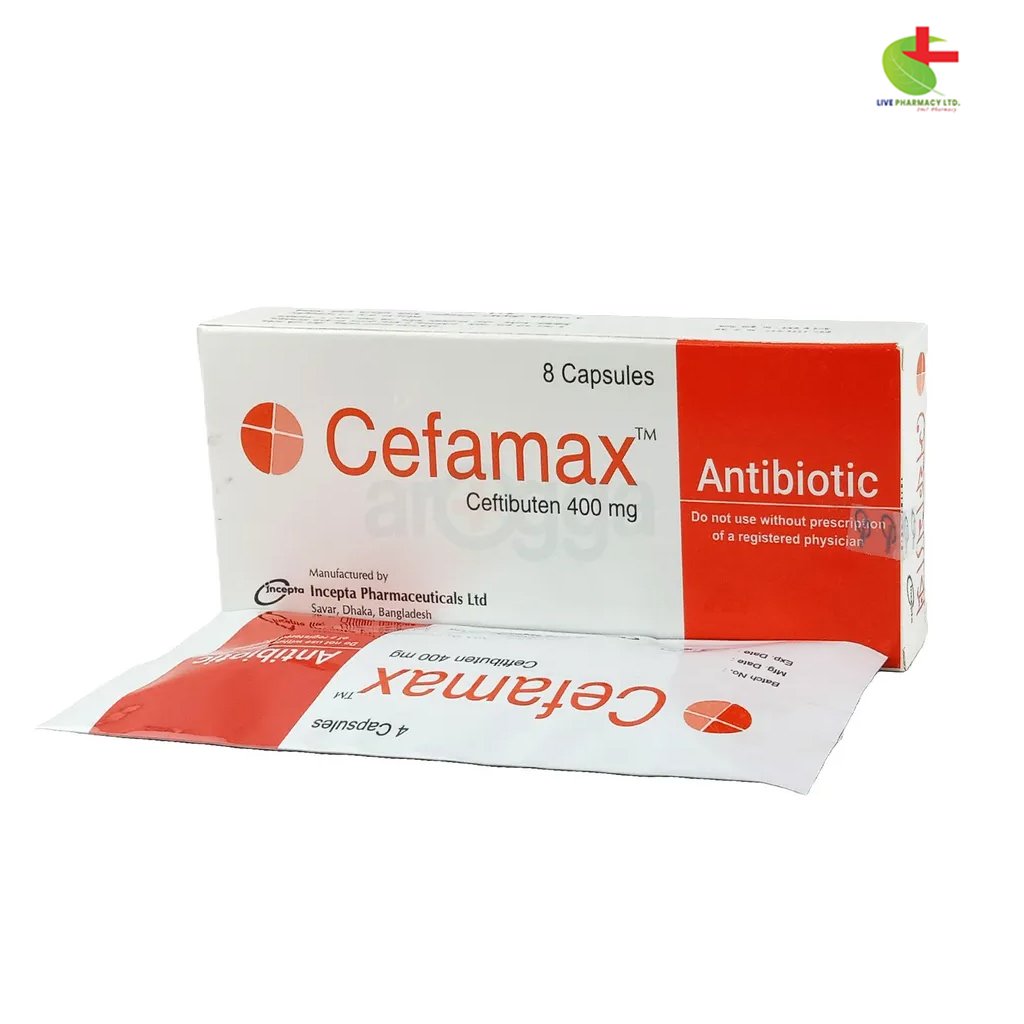Cefamax 400
480.00৳ Strip
- Cefamax is a semi-synthetic third-generation cephalosporin antibiotic.
- Indicated for the treatment of mild-to-moderate infections caused by susceptible bacteria.
- Effective against acute bacterial bronchitis, otitis media, pharyngitis, and urinary tract infections.
- Works by inhibiting bacterial cell wall synthesis.
- Recommended dosage: 400 mg daily for adults, with tailored doses for children.
- Generally well tolerated; consult a healthcare professional before use.
 Brand
Brand
|
Incepta Pharmaceuticals Ltd |
|---|---|
 Generics
Generics
|
Ceftibuten Dihydrate |
 Type
Type
|
Capsule |
Indications
Cefamax is designed to treat mild-to-moderate infections caused by susceptible microorganisms, specifically in the following conditions:
- Acute Bacterial Exacerbations of Chronic Bronchitis: Effective against Haemophilus influenzae (including beta-lactamase producing strains), Moraxella catarrhalis (including beta-lactamase producing strains), and penicillin-susceptible strains of Streptococcus pneumoniae.
- Acute Bacterial Otitis Media: Targeting infections due to Haemophilus influenzae, Moraxella catarrhalis, and Streptococcus pyogenes.
- Pharyngitis and Tonsillitis: Primarily caused by Streptococcus pyogenes.
Pharmacology
Ceftibuten, the active component of Cefamax, is a semi-synthetic cephalosporin antibiotic formulated for oral use. It exerts its bactericidal effects by binding to essential proteins in the bacterial cell wall, inhibiting cell wall synthesis.
Dosage & Administration
Otitis Media:
- Adults: 400 mg orally once daily for 10 days
- Pediatrics (>6 months): 9 mg/kg/day (maximum 400 mg) for 10 days
Tonsillitis/Pharyngitis:
- Adults: 400 mg orally once daily for 10 days
- Pediatrics (>6 months): 9 mg/kg/day (maximum 400 mg) for 10 days
Bronchitis:
- Adults: 400 mg orally once daily for 10 days
- Pediatrics (>12 years): 400 mg orally once daily for 10 days
Cystitis:
- Adults: 400 mg orally once daily for 7 days
- Pediatrics (>12 years): 400 mg orally once daily for 7 days
Pneumonia:
- Adults: 200 mg orally every 12 hours for 7 to 14 days
- Pediatrics (>12 years): 200 mg orally every 12 hours for 7 to 14 days
Sinusitis:
- Adults: 400 mg orally once daily for 10 to 14 days
- Pediatrics (>12 years): 400 mg orally once daily for 10 to 14 days
Urinary Tract Infection:
- Adults: 400 mg orally once daily for 10 days
- Pediatrics (>6 months): 9 mg/kg/day (maximum 400 mg) for 10 days
Always follow your doctor’s advice when taking medication.
Interactions
Theophylline and antacids do not affect the pharmacokinetics of Cefamax, while ranitidine increases its Cmax and AUC.
Contraindications
Ceftibuten is not recommended for patients with a known allergy to cephalosporin antibiotics.
Side Effects
Common side effects may include nausea, headache, diarrhea, dyspepsia, dizziness, abdominal pain, and vomiting.
Pregnancy & Lactation
Ceftibuten is classified as Pregnancy Category B. Controlled studies in pregnant women are lacking, so it should be used only if the benefits outweigh the risks. The excretion of Ceftibuten in breast milk is unknown, so caution is advised during breastfeeding.
Precautions & Warnings
Prolonged use of broad-spectrum antibiotics like Cefamax may lead to the development of resistant organisms. Close monitoring of the patient is crucial. Dose adjustments may be necessary for patients with renal impairment, and caution should be exercised in individuals with a history of gastrointestinal disorders, particularly colitis.
Use in Special Populations
Renal Impairment:
- CrCl 5 to 29 ml/min: 2.25 mg/kg or 100 mg orally once daily
- CrCl 30 to 49 ml/min: 4.5 mg/kg or 200 mg orally once daily
Hepatic Impairment: No dose adjustment is needed.
Therapeutic Class
Third-generation cephalosporins.
Reconstitution
- The small bottle contains purified water; the large bottle contains granules.
- Pour the purified water completely into the large bottle.
- Secure the cap and shake for at least one minute.
- Use a measuring cup or dropper for the reconstituted suspension.
The prepared suspension should be consumed within 14 days if stored in the refrigerator. Shake well before each use.
Storage Conditions
Store below 25°C, away from light and moisture. After reconstitution, the suspension can be used for 14 days when stored at 2° to 8°C. Keep out of reach of children.













Reviews
There are no reviews yet.